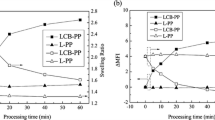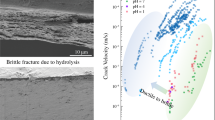Abstract
Poly(lactic acid) is the subject of considerable commercial development by a variety of organizations around the world. In this work, the thermal and rheological properties of two commercial-grade poly(lactic acid)s (PLAs) are investigated. A comparison of the commercial samples to a series of well-defined linear and star architecture PLAs provides considerable insight into their flow properties. Such insights are valuable in deciding processing strategies for these newly emerging, commercially significant, biodegradable plastics. Both a branched and linear grade of PLA are investigated. The crystallization kinetics of the branched polymer are inferred to be faster than the linear analog. Longer relaxation times in the terminal region for the branched material compared to the linear material manifests itself as a higher zero shear rate viscosity. However, the branched material shear thins more strongly, resulting in a lower value of viscosity at high shear rates. Comparison of the linear viscoelastic spectra of the branched material with the spectra for star PLAs suggests that the branched architecture is characterized by a span molecular weight of approximately 63,000 g/mol. The present study conclusively demonstrates that a wide spectrum of flow properties are available through simple architectural modification of PLA, thus allowing the utilization of this important degradable thermoplastic in a variety of processing operations.
Similar content being viewed by others
References
R. Datta, S. Tsai, P. Bonsignore, S. Moon, and J. R. Frank (1995) FEMS Microbiol. Rev. 16, 221–231.
D. R. Witzke (1997) Introduction to Properties, Engineering, and Prospects of Polylactide Polymers, Michigan State University, Ann Arbor, MI, p. 389.
P. R. Gruber, M. H. Hartmann, J. J. Kolstad, D. R. Witzke, and A. L. Brosch (1996) Method of Crosslinking PLA, USA, PCT 94 /08 508.
M. H. Hartman (1998) High Molecular Weight Polylactic Acid Polymers D. H. Kaplan (Ed.), Springer Verlag: Berlin, pp. 367–411.
J. J. Cooper-White and M. M. Mackay (1999) J. Polym. Sci. Part B: Polym. Phys. 37, 1803–1812.
J. Wang, R. Kean, J. Randall, and D. Giles (1997) Society of Rheology Annual Meeting Poster PO24: Melt Rheology of Polylactide, Columbus, OH.
D. S. Pearson and E. Helfand (1984) Macromolecules 17, 888–895.
R. C. Ball and T. C. B. McLeish (1989) Macromolecules 22, 1911–1913.
S. T. Milner and T. C. B. McLeish (1997) Macromolecules 30, 2159–2166.
J. R. Dorgan and J. S. J. Williams (1999) Rheology 43, 1141–1155.
W. W. Graessley (1977) Accnts. Chem. Res. 10, 332–339.
Author information
Authors and Affiliations
Rights and permissions
About this article
Cite this article
Dorgan, J.R., Lehermeier, H. & Mang, M. Thermal and Rheological Properties of Commercial-Grade Poly(Lactic Acid)s. Journal of Polymers and the Environment 8, 1–9 (2000). https://doi.org/10.1023/A:1010185910301
Issue Date:
DOI: https://doi.org/10.1023/A:1010185910301




